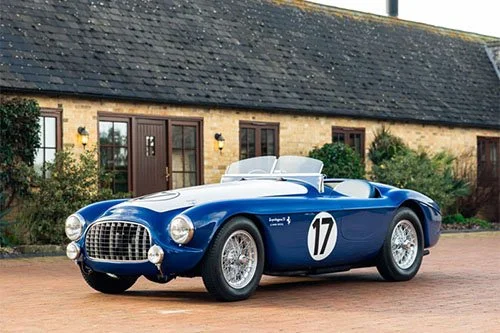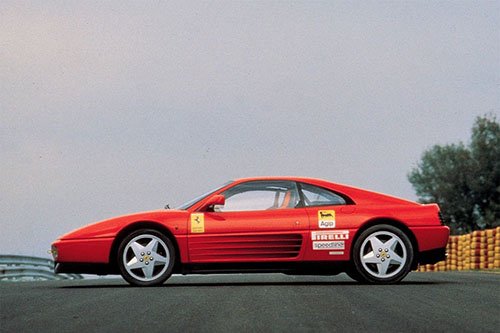Guide: Ferrari 410 Pinin Farina Superfast 1
Background
At the Turin and Paris motor shows of 1956, Pinin Farina unveiled a trio of models that were at the cutting edge of aerodynamic understanding.
Based on state-of-the-art underpinnings, the two Alfa Romeo Superflows and solitary Ferrari Superfast mixed space-age styling with competition-bred mechanicals.
First to arrive was the Alfa Romeo Superflow 1 displayed at the Turin Motor Show between late April and early May.
Under the skin, this extraordinary looking machine was an Alfa Romeo 6C 3000 CM racing car of the type used at the 1953 Mille Miglia and Le Mans 24 Hours.
Painted white with a blue swage line and matching interior, the Superflow 1 featured visually exposed front wheels shrouded by Plexiglas fenders and a transparent cockpit canopy with Gullwing upper door elements. Finned rear wings were also adopted to complete the other-worldly look.
At the Paris Motor Show in early October, the same car was reconfigured as the Superflow 2. Modified with a shortened nose and conventional front fenders, this time it was presented in a red colour scheme with white used for the swage line, centre stripe and noseband.
Also present in Paris was the Ferrari 410 Superfast 1 (chassis 0483 SA).
Bodywork
Like the Superflow 1 and 2, the Ferrari Superfast 1 featured headlights mounted behind streamlined covers, a cantilevered roof with no A-posts and dramatic tail fins that obscured its pointed tail.
Instead of a transparent canopy, the Superfast 1 had a conventional roof with body coloured sail panels that housed two vents each side.
Unusual touches included a wiper for the large rear windscreen and partially enclosed rear wheels.
The Superfast 1 was among the first cars to have rubber inserts applied to chrome bumperettes; two of these were vertically mounted at either end.
Unlike most coachbuilders, Pinin Farina were typically quite reserved in their use of chrome; on the Superfast 1, it was applied to the trailing edge of the hood scoop, the engine cooling vents carved out from each flank, the door handles, window frames, wipers, front grille, swage line and badges.
The finished car was painted two-tone white and silver.
Interior
The beige interior was to left-hand drive specification and strictly for two passengers. It featured a pair of well-padded seats with an armrest in between.
The crackle black dash housed three main dials; a tachometer on the left, a speedometer on the right and a combined oil pressure / water temperature / fuel gauge in the centre.
Additional switches were housed on a central console that linked the dash and transmission tunnel.
Chassis
Pinin Farina had received the Superfast 1’s rolling chassis from Ferrari in early August 1956. It was numbered 0483 SA with the SA suffix denoting Superamerica lineage.
However, unlike the Series 1 410 Superamerica available at the time, the Superfast 1 was constructed on a unique chassis with a shortened 2600mm wheelbase. This was 200mm less than normal but both types were designated Tipo 514.
The chassis was a conventional tubular steel ladder type frame manufactured by Gilco Autotelai in Milan.
Front suspension was via independent unequal length wishbones, coil springs and telescopic shocks. At the rear was a live axle with semi-elliptic springs and more telescopic shocks.
Hydraulic drum brakes were fitted all round along with Englebert-shod 16 x 6.5-inch Borrani wire wheels.
Engine & Gearbox
In addition to its special chassis, the Superfast 1 was equipped with a competition engine.
Sourced from the 410 Sport racing car, the Tipo 126/C single overhead camshaft 60° V12 was the latest Lampredi big-block motor from Ferrari.
Although it retained the same 4961cc displacement and 8.5:1 compression ratio as the standard Tipo 126 unit used in the Superamerica, the Superfast 1’s engine came with a twin-plug head, dry-sump lubrication and three enormous Weber 46 DCF carburettors.
By contrast, the 410 Superamerica had a single-plug head, wet-sump lubrication and Weber 40 DCF carbs.
The Superfast 1 would therefore have produced close to 380bhp at 7000rpm (as per the 410 Sport) as opposed to 340bhp at 6000rpm (for the 410 Superamerica).
The gearbox was a four-speed unit with triple plate clutch.
Performance
With its monster engine and advanced aerodynamic styling, the Superfast 1 was probably the quickest road car of its day. A top speed in excess of 170mph would likely have been possible along with a 0-62mph time of around 5.5 seconds.
Subsequent History & Legacy
After the 1956 Paris Motor Show, 0483 SA was sold to William Doheny of Brentwood, California.
Doheny already owned a 121 LM and 750 Monza (painted matching shades of dark blue). He was a director of the Union Oil Company and the grandson of pioneering oil tycoon, Edward Doheny.
Pinin Farina went on to create several Ferrari Speciales inspired by the Superfast 1. They included 410 Superamerica Series 2 chassis 0719 SA (sold to Jan de Vroom), 250 GT chassis 0725 GT (sold to Prince Bernhard of Holland) and 250 GT chassis 0751 GT (sold to Princess Lilian of Belgium).
Text copyright: Supercar Nostalgia
Photo copyright: Ferrari - https://www.ferrari.com

































